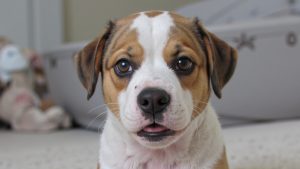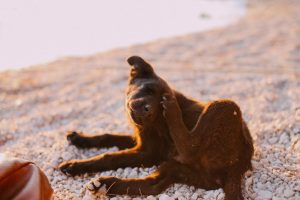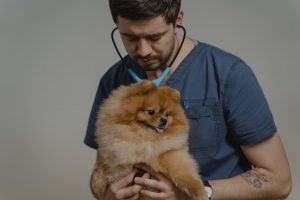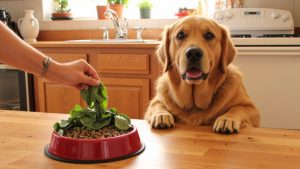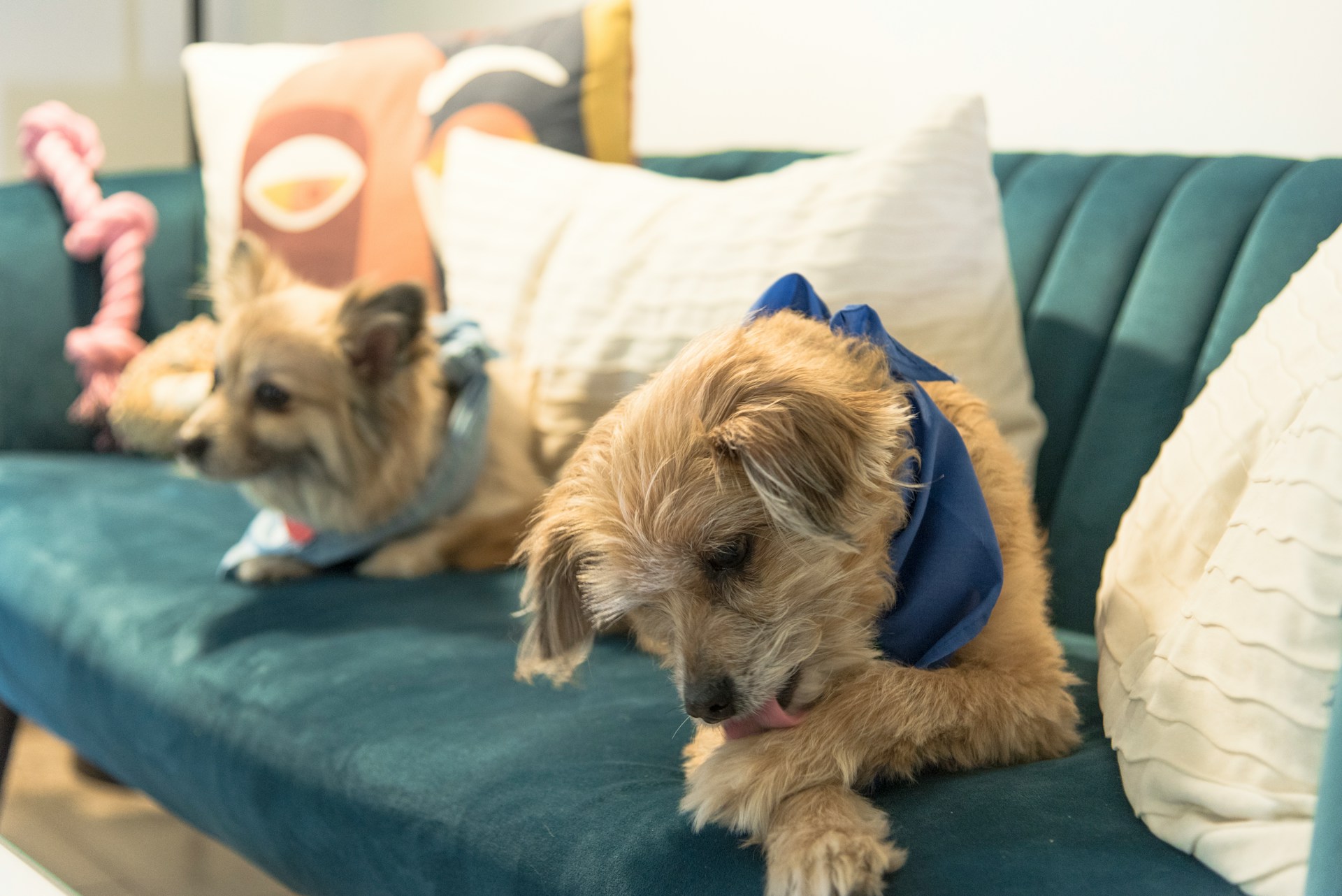
The sound is unmistakable—slurp, slurp, slurp. Your dog is licking their paw again in the middle of the night. While dogs naturally lick their paws to clean after walks or remove debris, excessive licking that leads to raw, inflamed skin indicates an underlying issue.
Raw paws create vulnerable entry points for bacteria and fungi, potentially transforming minor irritation into painful infections that require veterinary attention. Redness, swelling, and bleeding are clear signs that your dog needs help.
The key difference between normal grooming and problematic paw-licking lies in duration and intensity. While occasional cleaning is healthy, persistent attention to one area suggests your dog is trying to soothe discomfort or pain. Identifying this distinction helps address the root cause of their distress.
What Causes Dogs to Lick Their Paws?
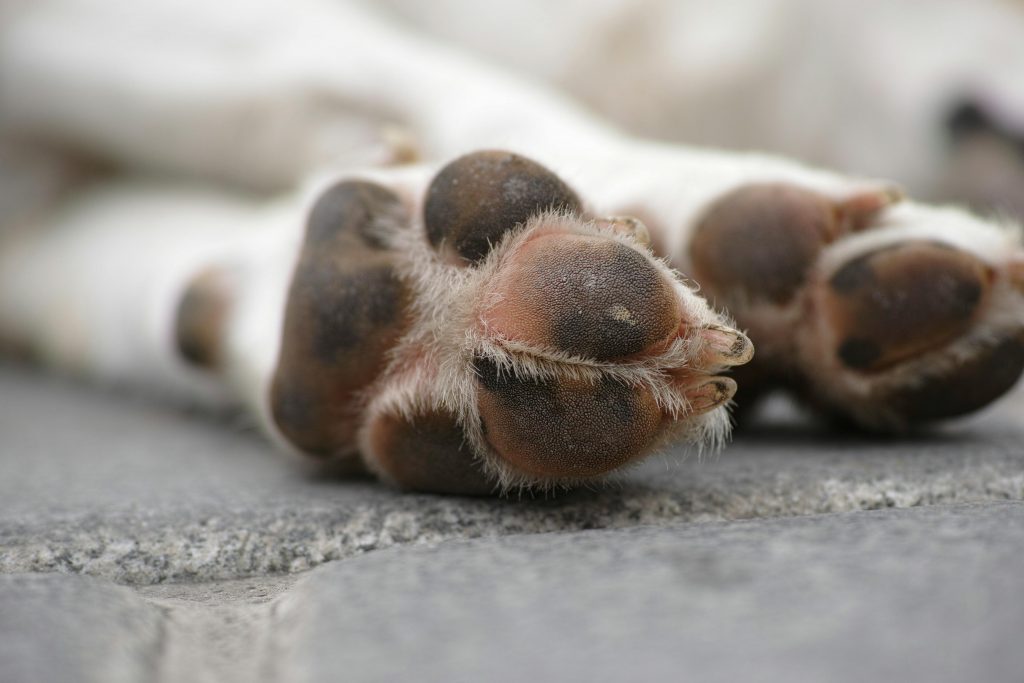
When your dog constantly licks their paws, it signals an underlying issue that needs attention. The causes range from allergies to infections, each requiring different treatment approaches.
Environmental Allergies
Environmental allergies are the most common cause of excessive paw licking. Dogs absorb allergens through their skin and paws, unlike humans who typically react through inhalation. Seasonal pollen, grass, dust mites, and mold spores often trigger these reactions. Golden Retrievers, Labrador Retrievers, and West Highland White Terriers show greater genetic predisposition to these sensitivities.
Dogs typically lick their front paws when experiencing allergic responses. Those with white fur often develop brown staining from persistent licking. Licking typically increases after outdoor activities during allergy seasons.
Food Allergies
Food sensitivities, while less common than environmental allergies, can cause significant paw discomfort. Common allergens include beef, dairy, chicken, and wheat. These allergies trigger immune responses causing intense itchiness and potential gastrointestinal issues.
Dogs can develop food allergies between six months and five years of age, even without dietary changes. Consider food allergies if your dog shows paw licking alongside digestive problems.
Seasonal Irritants
Winter brings challenges from road salt and de-icing chemicals, which can cause chemical burns on dog paws. These irritants often become trapped between toe pads, creating discomfort that prompts licking.
In summer, hot pavement can burn sensitive paw pads. Even brief exposure to scorching surfaces can cause significant damage, leading to painful walking and persistent licking.
Yeast and Bacterial Infections
The warm, moist spaces between paw pads create ideal conditions for yeast and bacteria. These infections cause inflammation, redness, swelling, and emit a distinctive musty odor. Dogs with fold-heavy paws or those frequently exposed to wet environments face higher risk.
Untreated infections create a cycle: licking for relief introduces more moisture, worsening the infection. Dogs typically focus on specific spots between toes rather than the entire paw.
Interdigital Cysts
These fluid-filled lumps between toes cause significant discomfort. Often resulting from bacterial infections, foreign bodies, or trauma, these cysts prompt targeted licking. Large breeds with short, coarse hair like Bulldogs and Labrador Retrievers show greater predisposition.
Cysts typically affect single paws or specific locations, unlike allergic reactions that might affect multiple paws.
Dry Skin and Hyperkeratosis
Cracked, dry paw pads trigger licking behavior. Hyperkeratosis causes abnormally thick, hard skin on pads, creating a rough texture that becomes uncomfortable.
This condition develops with age or appears as a symptom of other health issues. The thickened skin loses flexibility, cracks easily, and becomes painful, prompting dogs to lick for relief.
Physical Injuries
Foreign objects like splinters, foxtails, or small rocks can lodge between toes or embed in paw pads. These injuries cause sharp pain, leading to persistent licking at the exact spot. Cuts, scrapes, and puncture wounds similarly trigger licking as dogs attempt to self-heal.
Physical injuries typically cause sudden, focused licking on one paw rather than affecting all four equally. Careful examination often reveals the source of pain.
Understanding these causes helps identify why your dog licks their paws excessively. Quick identification allows for targeted treatment, bringing relief and ending this distressing behavior.
How Can Pain and Anxiety Lead to Paw Licking?
Dogs communicate discomfort through various behaviors, including persistent paw licking. This behavior often indicates underlying physical pain or emotional distress.
Pain-Induced Paw Licking
When dogs experience pain, particularly in joints or limbs, they often lick as a natural response. Dogs with arthritis frequently target their paws, not because the paws hurt, but to soothe pain radiating from nearby joints.
Older dogs with osteoarthritis may lick the paw closest to a painful joint when they can’t reach the actual source of discomfort. Watch for signs like stiffness when rising, reluctance to climb stairs, decreased playfulness, or unusual irritability. These behaviors, combined with paw licking, indicate physical pain.
Dogs might also lick due to cuts, foreign objects between toes, burns from hot pavement, or chemical irritants. A careful examination between the toes can reveal these less obvious causes.
Anxiety-Driven Licking
Dogs sometimes lick their paws to cope with emotional distress. This self-soothing behavior releases endorphins, creating temporary calm during stressful situations, similar to humans biting nails when nervous.
Separation anxiety commonly triggers this behavior. Dogs distressed by their owner’s absence may develop compulsive paw licking that continues even when the owner returns. This coping mechanism becomes difficult to break without addressing the underlying anxiety.
Additional anxiety signs include restlessness, pacing, excessive panting unrelated to heat or exercise, increased drooling, avoiding interaction, and unusual vocalizations. Dogs might also display destructive behaviors or have indoor accidents despite being house-trained.
Recognizing the Difference
Distinguishing between pain and anxiety-related paw licking requires careful observation. Pain-related licking typically focuses on a specific paw and may accompany limping or visible discomfort. Anxiety-driven licking usually involves multiple paws and intensifies during stressful situations.
If your dog pauses licking when visitors arrive or during exciting activities, then resumes when calm returns, this suggests anxiety rather than physical pain. Consistent licking of one paw, regardless of circumstances, indicates a physical issue.
Each cause requires different treatment approaches, but both need prompt attention. Persistent licking can lead to sores, infections, and discomfort that worsen your dog’s original condition.
When Should You Be Concerned About Paw Licking?
Dogs naturally clean their paws from time to time, but knowing when this behavior becomes concerning can save your dog unnecessary discomfort. Veterinarians recognize that excessive paw licking often signals an underlying issue that requires attention.
While canine skin is quite robust, it’s not designed to be licked compulsively. As such, the behavior could cause microscopic and then visible damage. Understanding this progression helps identify when normal grooming becomes problematic.
Warning Signs That Require Attention
Watch for these specific indicators that suggest your dog’s paw licking has become problematic:
- Redness or inflammation: Paws that appear pink, swollen, or hot to the touch indicate irritation causing discomfort.
- Hair loss between toes or on feet: Constant moisture from licking damages hair follicles, leading to patchy or bare areas.
- Discolored fur: Brown or reddish staining on light-colored paws comes from porphyrins in saliva and shows chronic licking.
- Visible injuries or foreign objects: Cuts, punctures, glass splinters, thorns, or embedded grass seeds can cause targeted licking.
- Limping or favoring a paw: If your dog hesitates to put weight on a foot they’re licking, pain is likely present.
Behavioral Red Flags
Beyond physical signs, certain behaviors suggest your dog’s paw licking requires veterinary attention:
When your dog continues licking despite distractions like toys or food, this persistence indicates significant discomfort. Dogs that wake from sleep to lick their paws are experiencing irritation severe enough to interrupt rest patterns.
Pay attention to sudden changes. If your dog begins focusing intensely on their paws, something has changed. This new behavior warrants investigation, especially when accompanied by other symptoms like lethargy or changes in appetite.
The Progression of Untreated Paw Licking
Without intervention, excessive paw licking creates a troubling cycle. The initial irritation causes licking, which damages skin further, leading to more irritation and licking. This cycle can progress from mild irritation to serious medical issues.
Veterinarians describe this progression: saliva staining appears first, followed by fur damage and breakage. Next, the skin barrier breaks down, allowing allergens and bacteria to enter. This leads to inflammation, scabbing, and eventually infection with oozing and odor.
When to Seek Veterinary Care
Schedule a veterinary appointment if you notice:
- Licking that persists for more than a few days
- Pain responses when you touch the affected paw
- Swelling that doesn’t improve with basic home care
- Any signs of infection (heat, odor, discharge)
- Behavioral changes accompanying the licking
One Border Collie owner discovered that her dog’s seemingly minor paw licking actually stemmed from an embedded grass seed that had begun migrating into the tissue between the toes. Early veterinary intervention prevented a more serious infection and potentially costly surgery.
Trust your instincts if something seems off with your dog’s behavior. Your observations combined with professional veterinary assessment provide the best chance for quick resolution and relief for your dog.
How Can You Treat and Prevent Raw Paws?
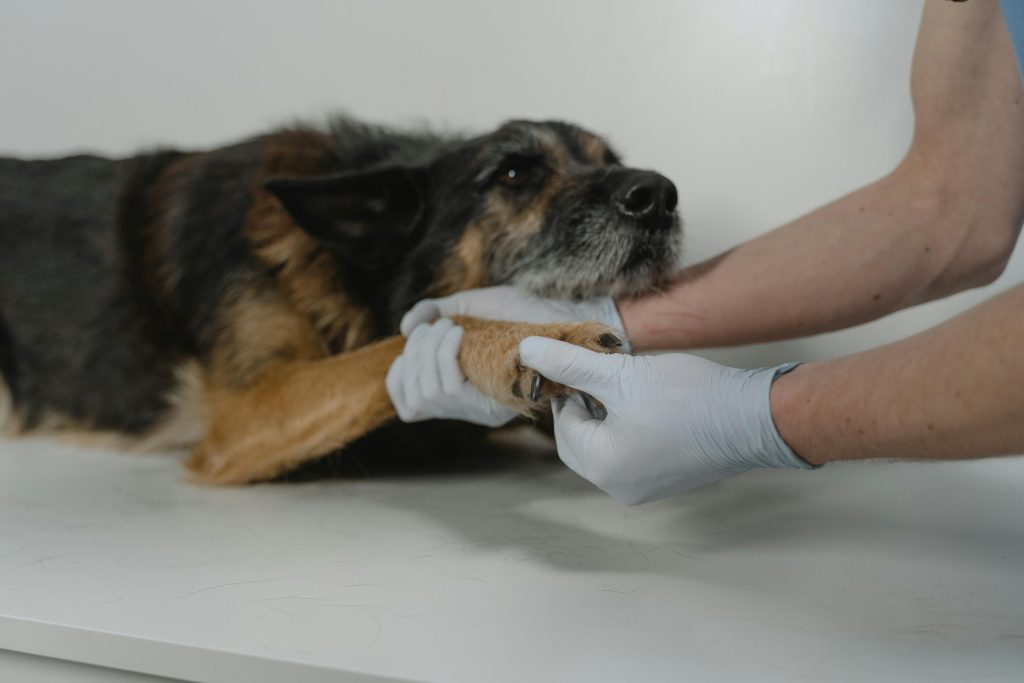
Raw paws can cause pain, excessive licking, limping, and discomfort in dogs. Quick intervention prevents the condition from worsening. Here are effective solutions to treat and prevent raw paws.
Topical Treatments
Several topical solutions can accelerate healing for raw paws:
Paw balms specifically formulated for dogs create a protective barrier while moisturizing cracked pads. Apply a thin layer and distract your dog with a treat or toy for 5-10 minutes to allow absorption. Look for products containing natural ingredients like coconut oil, shea butter, or calendula.
For mild irritation, a diluted chlorhexidine solution can clean the affected area before applying any balm. The antimicrobial properties help prevent infection while the paws heal.
Preventing Further Irritation
While healing, protect your dog’s paws from additional damage:
Consider dog booties for outdoor walks. They shield paws from hot pavement, winter salt, and rough terrain. If your dog refuses booties, limit walks to grass or soft surfaces and avoid extreme temperatures.
Regularly trim the fur between paw pads to reduce debris collection and matting. Overgrown fur traps moisture and foreign objects, creating perfect conditions for bacterial or fungal growth.
Long-Term Prevention Strategies
Regular paw care prevents many common problems. Establish a routine that includes:
Weekly paw inspections even when your dog shows no symptoms. Early detection prevents minor issues from becoming serious. Check between toes and around nail beds where problems often start.
Clean your dog’s paws after walks, especially in urban areas or during winter when sidewalks are treated with ice melt. A quick rinse removes potentially harmful chemicals before they cause irritation.
Consider your walking environment carefully. Hot asphalt can burn paw pads within minutes. Test surface temperature with your hand—if you can’t hold it there for seven seconds, it’s too hot for your dog’s paws.
By combining prompt treatment with preventive care, you can keep your dog’s paws healthy and comfortable. Most raw paw issues resolve quickly with proper attention, allowing your dog to return to comfortable walks and play without pain.
Conclusion: Protecting Your Dog’s Paw Health
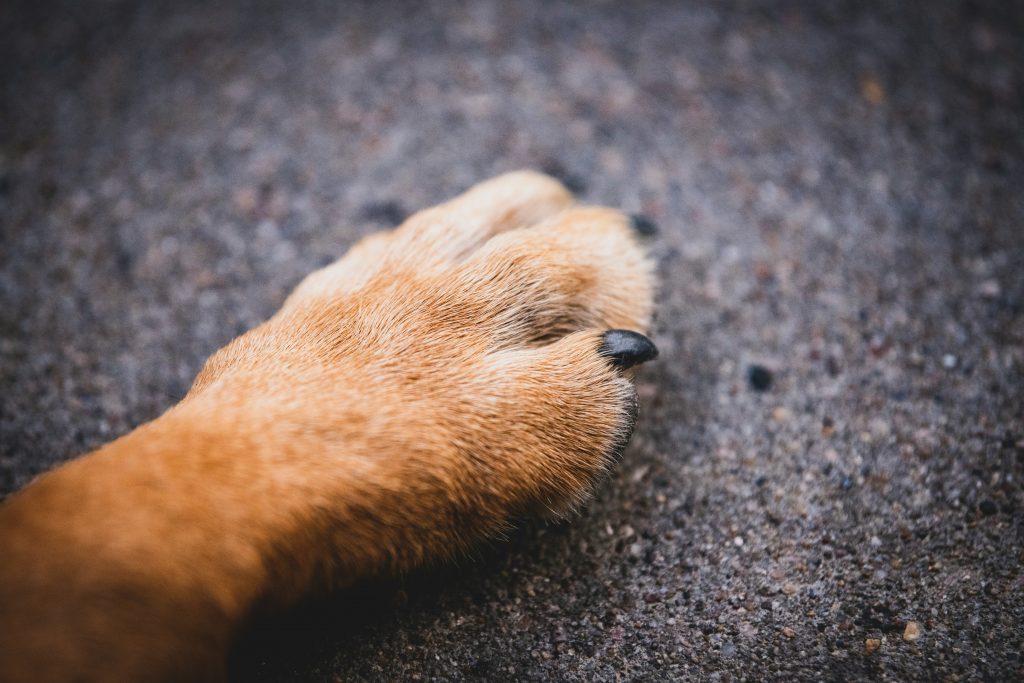
Addressing why your dog licks their paws raw is essential for their comfort, health, and wellbeing. The appropriate solution depends on the root cause – whether it’s allergies, infections, pain, or anxiety. Taking prompt action can prevent minor irritations from developing into serious health issues that require extensive treatment.
When your dog ventures outside—where allergens, irritants, or rough terrain can trigger paw licking—having real-time awareness of their environment can make all the difference. The Halo Collar empowers you with GPS tracking and customizable safe zones, allowing you to monitor where your dog walks, plays, or rests.
Interested in exploring other common dog health concerns? Visit our dog health page for expert tips and advice on a wide range of issues.
